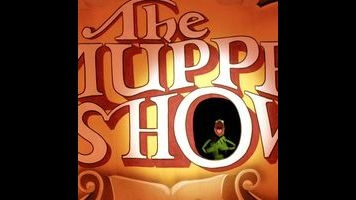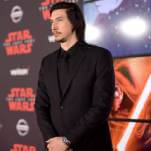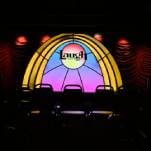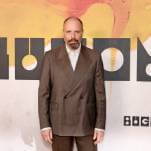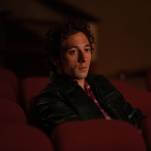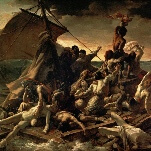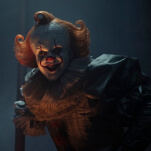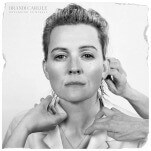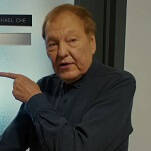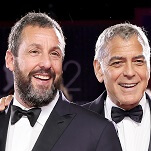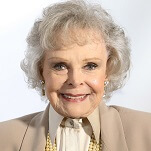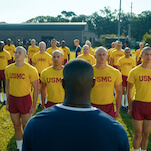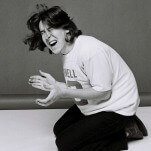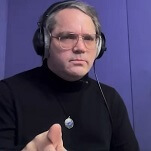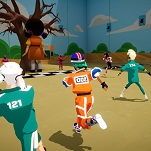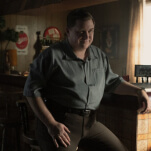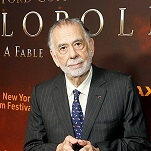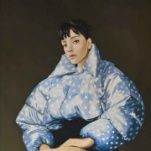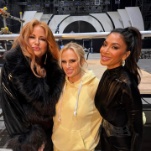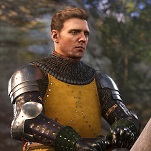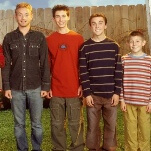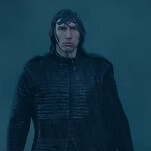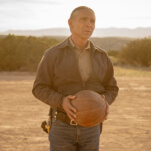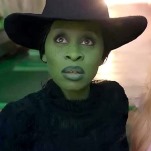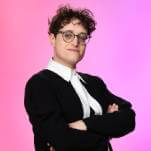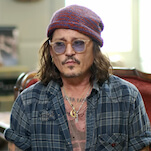“If The Muppet Show had a basketball team, the score would always be Frog 99, Chaos 98.”—Jerry Juhl
You could give a comprehensive, scene-by-scene breakdown of every episode of The Muppet Show and still fall short of describing how and why the show ticks as well and as incisively as writer-producer Jerry Juhl did in the quote above. To be fair, the quote is presented out of context—it’s technically an analogy describing Jim Henson’s uncanny ability to calmly float through the disordered atmosphere of a Muppet production—but it stands to reason that, even in these early episodes of the series, every episode of The Muppet Show is driven by a battle between Kermit The Frog and everything that could possibly go wrong in the course of 30 minutes. Though he could’ve just as easily couched his observation in a tennis analogy—The Muppet Show just as frequently feels like a series of volleys between Frog and Chaos, with Frog finally cinching match point as the episode draws to a close—but there are too many moving pieces on the series for that apply. Kermit’s the ultimate clutch point guard, the player who controls the movement of the ball and knows exactly who needs it in order to score the buzzer-beater that puts the show over the top.
Of course, for all the satisfaction that’s derived from Kermit making the right calls for his cast/teammates, it’s always funnier to watch as they actively work against him. Episode 114, starring singing-dancing-acting triple threat Sandy Duncan, places him in opposition to nearly every onscreen character (and one offscreen presence); the following episode, featuring a less confident performance by Candice Bergen, puts Kermit in the path of Fozzie Bear and his steamroller of a running gag.
It’s a joy to watch Kermit attempt to retain his sanity amid the madness, and a lot of that has to do with Jim Henson’s performance. It wasn’t until recently that I noticed how the simple, flexible construction of Kermit’s head allowed Henson to express such a broad range of emotions through his signature character. And it doesn’t take much to do so—Henson could suggest a complete change of mood by simply re-arranging his fingers. That’s all the more astounding considering the cool, collected exterior suggested by Juhl’s original quote. There’s no doubt in my mind that Henson could project such an outward appearance because he had a fuzzy green relief valve for all the anxieties related to mounting The Muppet Show.
Episode 114: Sandy Duncan
“With our special guest star”: You don’t see a lot of careers follow the trajectory of Sandy Duncan’s these days: A Broadway star who smoothly transitioned to television without having to drop too many of the qualities that worked for her on the stage. (Maybe Kristin Chenoweth and Idina Menzel—both of whom would make great modern-day Muppet Show hosts—though in their cases, the existence of Glee certainly helped get them further television work.) Of course, Duncan projects a bit too much innocence to have been a star in cynical times like these, much better suited for a time period when high-kicking choreography was a regular sight on TV and puppets could run an entire primetime variety show. In spite of their shared wholesomeness, Duncan and The Muppets inject a little scandalousness into this edition of The Muppet Show, which begins with a scene set in a seedy bar, and prompts Waldorf to
- muse “[Duncan] makes me feel like a young girl—I think I’ll go find one,” and
- wonder aloud if a temporarily absent Statler has leapt to his death from the booth.
Having an upwardly mobile old-fashioned VIP like Duncan around provides a decent excuse to work some additional showbiz schtick into the episode, also. More about which in the next category…
“The most sensational, inspirational, celebrational”: Fozzie introduces an influential force in The Muppet Show’s mythology this week: Gags Beasley, the unseen writer who supplies the bear with material at $5/laugh. Beasley and his (allegedly) uproarious “Banana Sketch” are legends to everyone on the show, save for Kermit—I say “allegedly” because, in the grand tradition of Monty Python’s “The Funniest Joke In The World,” the actual content of the sketch is withheld from the audience. It’s a brilliant bit of comedy via restraint, a way to throw Kermit temporarily off balance, and a sly joke at the way people tend to hold certain, rarified showbiz types in absurdly high esteem for no discernible reason. If the appeal of a pop-culture object has ever escaped your grasp, you can certainly sympathize with Kermit’s consternation involving Beasley and his magnum opus.
“It’s like a kind of torture to have to watch the show”: That said, for an episode based around whispers of a comedy legend, there are a few jokes in this episode that are simply to dry to land. In particular, this exchange from At The Dance that still has me scratching my head:
MALE PIG: Where did you say you were born?
FEMALE PIG: Paris.
MALE PIG: How did you do that?
FEMALE PIG: Oh, the usual way.
I can’t tell where the wordplay is or what that twist on “the usual way” is supposed to be. I’ll call this one my own personal “Banana Sketch” for the time being.
“It’s time to play the music”: In a curious foreshadowing of one of Duncan’s most famous roles—Peter Pan—her musical numbers are all upstaged by Muppet moppet Mary Louise and her ravenous rendition of “Never Smile At A Crocodile.” Originally appearing in Disney’s animated take on the boy who never grew up, the song makes a great showcase for a minor character who never found a consistent performer (Fran Brill handled “I’m In Love With A Big Blue Frog” during the Paul Williams episode, but Mary Louise is in the hands of designer/builder Rollie Krewson this time around). The character is hilariously blithe about her mount dispatching the reptiles with which she’s usually associated—perhaps that’s why Kermit submits to the rough treatment of Mary Louise seen in Episode 208.
“It’s time to raise the curtain”: This episode presents the furry, orange monster Behemoth as a full-bodied puppet for the first and only time. I have to wonder if this decision was made to accommodate Duncan, who lost sight in her left eye in the 1970s, which could have made it difficult for her to navigate around platforms and puppeteer trenches. In the Muppet Show sketches that require the most movement from Duncan—“A Nice Girl Like Me” and the Sweetums and Behemoth feature “Inner Beauty”—she’s on equal footing with the Muppets and their performers.
“It’s time to meet The Muppets”: The late Richard Hunt had a gift for giving his Muppet characters a real sense of vulnerability—a defining feature for Sweetums which gains greater shading during “Inner Beauty.” The monster is a brute, but a gentle one, and in all the gruffness of Hunt’s vocal characterization, there’s a very human sadness to the way Sweetums laments how people react to him. That’s a well the Muppet monsters return to with great frequency, but it’s particularly poignant coming from the biggest and meanest-looking of the bunch.
“It all ends in one of two ways”: This episode sets a high bar for future episodes in terms of frog trauma: At the end of his opening monologue, Kermit is blown into (and out of) Statler and Waldorf’s box by Crazy Harry; later, Mary Louise’s crocodile enacts a reverse Henson ending by allowing his amphibious meal to escape from the confines of his stomach. It’s the most adorable instance of vomiting ever caught by a TV camera.
Episode 115: Candice Bergen
“With our special guest star”: Look, I like Candice Bergen a lot. Murphy Brown hasn’t aged well (How ’bout that Dan Quayle, huh?), but her star turn on the sitcom transcended the shortcomings that sunk Bergen’s efforts as a dramatic actress in the ’70s. It’s curious that it took her until the late ’80s to take a full-time stab at comedy, particularly in light of her winning efforts at mixing it up with The Not Ready For Prime-Time Players on Saturday Night Live. Yet despite working with the Land of Gorch characters on SNL and being the daughter of Edgar “One Of Jim Henson’s Biggest Influences” Bergen, she’s a stiff throughout her appearance on The Muppet Show. Maybe it was jet lag, maybe she felt overwhelmed by the scale of the production—either way, in segments like “Look At That Face” and “Friends,” Bergen just doesn’t appear to be able to loosen up. The episode gives its guest a hand by throwing her characters like the snooty world traveler Miss Clara Cartwell and the put-upon country wife of “Put Another Log On The Fire”—but even in the latter segment, there’s an unfortunate lack of conviction from Bergen as she hauls off and fires a few shotgun rounds in the name of feminism.
“The most sensational, inspirational, celebrational”: All that said, my favorite moment of the episode contains a refreshingly honest reaction from Bergen—even if it only lasts for a few seconds. Finally fed up with Fozzie’s string of visual puns, Kermit delivers a pie to the bear—right to his face, in fact. When the prop cream doesn’t stick to the puppet’s fur, Bergen’s response is one of genuine shock and amusement—a response that’s amplified after Kermit’s second attempt at pieing Fozzie sends a piece of the pie flying in her direction. In a controlled environment such as The Muppet Show, it’s rare to catch a glimpse of something so spontaneous; it’s even rarer for that spontaneity to garner the guest’s biggest laugh.
“It’s like a kind of torture to have to watch the show”: “Look At That Face”—where several Muppet art students prove that beauty is in the eye of the beholder by remaking Bergen in their own images—is a clever riff on accusations that the guest was little more than a pretty face. But Bergen’s performance in the segment almost reinforces those accusations, particularly in the lingering close-up shot where she crosses her eyes and flares her nostrils to minimal comedic effect. She doesn’t really register the segment’s punchline, either—after Animal is instructed to “paint her,” he applies a few strokes of blue to Bergen’s skin, which prompts an off-puttingly blasé response. It’s not exactly work befitting a future five-time Emmy winner for Outstanding Lead Actress in a Comedy Series.
“It’s time to play the music”: The U.K. Spot features Rowlf subbing for Kermit in the struggle against Chaos, attempting to squeeze a reprise of Cy Coleman and Dorothy Fields’ “It’s Not Where You Start” into the space of one minute—before Scooter’s uncle demands an additional 20-second spin on the tune. The segment blends music and comedy in singularly Muppet Show fashion, with Scooter standing by and counting down the seconds as Rowlf races to the finish. You’d think an old showbiz hand like Rowlf would be used to this kind of stuff by now, but he crumples into a heap after the final note, giving Scooter the space to deliver a priceless rejoinder to the line “I’m going to finish on time.” “Nearly,” replies the gofer. It’s a punchline and an illustration of the fact that Richard Hunt (performing Scooter here) and Henson (as Rowlf) were just as reliable a comedic pairing as Henson and Frank Oz.
“It’s time to raise the curtain”: “What Now, My Love?” features some nifty Muppet Show sleight of hand, as the backing chorus’ transformation is made possible by camera movements and the general distraction of Piggy’s diva behavior. Like last week’s “You Do Something To Me,” it manages to string together a fluid musical number through multiple cuts.
“It’s time to meet The Muppets”: The Swedish Chef is one of the few characters who appeared more or less fully formed in the Sex And Violence pilot—not that there was a whole lot of evolution necessary to get the character to his full potential. The Chef’s Scandinavian gibberish is the type of referential signpost that continually shows up in non-Muppet media—see the recent edition of The Thrilling Adventure Hour podcast featuring a displaced viking who spoke in a similar dialect—and his preparation of a chili from the Tex Avery cookbook contributes some crucial terms to that invented language, including the all-purpose adjective “speecy-spicy.”
“It all ends in one of two ways”: Perhaps if Bergen’s camera was coated in the Chef’s chili (the steam build-up from which ultimately blows his hat into the sky) Sweetums would feel a touch more remorseful about eating it. In a culinary coincidence, Kermit is covered in flour (following Fozzie’s “Flour for Kermit The Frog” joke) after he’s swallowed by the suddenly shorter Behemoth for the benefit of a Veterinarian’s Hospital punchline. (Also, it’s not an explosion, per se, but George does conclude At The Dance by “popping the question”—meaning a fellow dance-goer with a question-mark balloon for a head. Near as I can tell, this is the last of the ill-fated, balloon-headed characters we’ll encounter on The Muppet Show.)
In two weeks: The Muppet Theater will be closed for the holidays next week (why not mark the occasion by watching A Muppet Family Christmas?) but when we return in 2012, the new year begins with an assist from head writer Jack Burns (his comedy partner Avery Schreiber) and an explosive (Did somebody say explosive?) appearance by Ben Vereen.
